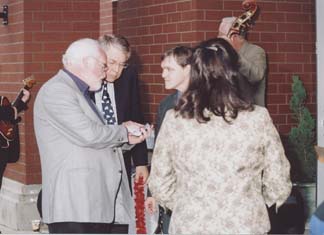 |
||||||||
| MEMO BLOG | Memo Calendar | Memo Pad | Business Memos | Loaves & Fishes | Letters | Home | ||
LEE PERLMAN
THE MID-COUNTY MEMO
 |
| Last month there was a grand opening and ribbon cutting ceremonies for The Heights at Columbia Knoll, a new 335-unit development in Mid-county. Before the speeches and pageantry, Development Partner Len Brannen, from left, huddles with Portland Development Commission Chair Eric Parsons and City Commissioner Eric Sten. |
| MEMO PHOTO: TIM CURRAN |
Visitors were treated to buffet lunches, entertainers at several locations, a casino, games on the building's outdoor decks, and free hearing aid, foot care and naturopathic clinics. The activities amounted to a creative self-guided tour of the 208-unit structure, with most units still available at $1,160 to $1,660 a month.
Already open, and mostly occupied, is The Terrace, 118 affordable family units housed in nine multi-family structures on the slopes of the ten-acre property on Northeast Sandy Boulevard at 82nd Avenue. Another feature is a two-story community center containing a day care center run by Grandma's Place. The final component is nine two- to three-bedroom town homes that will be located in the northeast corner of the site. According to Brannon, his Shelter Resources Corporation is "just finalizing" the design of these structures, which should sell for $285,000 to $310,000.
At 335 units and $45 million, The Heights is "the largest single housing project the Portland Development Commission has ever been involved with," the agency's Executive Director Bruce Warner said at the celebration. PDC provided $3 million of the financing in the form of a long-term loan and arranged for a 10-year tax exemption for the property. It also helped The Heights navigate through some formidable regulatory obstacles.
When Brannen first approached property owner John Goss in the late 1990s, he had been trying to sell the land for years without success. It was zoned for residential development, but it was occupied by the Shriners Hospital building, long vacant and unsuitable for residential use, protected from demolition as a designated historic landmark.
Shelter Resources representatives spent more than a year meeting with the Central Northeast Neighbors coalition, and the Roseway and Sumner neighborhood associations. They eventually convinced the majority of these activists that their project was a reasonable use of the property, and that it was not feasible to use the existing buildings for this purpose. A significant exception was Roseway's Peter Meijer; assisted by the State Historic Preservation Office and other amateur preservationists, he fought bitterly for the preservation of the buildings. Shelter Resources eventually made the case for demolition after agreeing to provide historic mementos of the hospital at several locations on the property. In another gesture, at the urging of Sumner's Joan Gray, they went to some lengths to preserve some stately trees at the top of the hill. As a large, stately building at the top of the hill overlooking Sandy Boulevard, The Terrace is reminiscent of the old Shriners Hospital.
"PDC was very conscious of neighborhood sentiment about this place," Brannen said. "The Shriners Hospital is in the memory of many people. At first I was somewhat leery of the process; I was afraid it could be confrontational. But in this case, there was a lot of return. It produced a pretty good product and some things I wouldn't have thought to do."
What the development team brought to the project was the combination of different types of housing on one site, the services and amenities provided, and the price range, Brannen said. "At this level of quality there's nothing else like this in the northwest, and very few in the country," he said. Noting that 60 percent of seniors have annual incomes below $25,000, he said, "We're providing access for ordinary people to retirement living that's respectable, with features of higher-priced products, a package that's really neat. We have a concierge service - you won't find that even in market-rate housing.
"People say, 'Let the market determine what the product will be.' You need a combination of private enterprise and a determination of what the product should be. Here we said, 'Let's stretch the envelope and make something happen,'" Brannen said.
Of the concept of combining senior and younger households in one project he said, "Seniors are as interested in being in a socially active place as anyone."
City Commissioner Erik Sten, City Council's foremost housing advocate, told those present that a community of "almost 700 people" would help boost the enrollment of nearby public schools and a market for local businesses. "This is a very special place and always has been," he said. "It's not just for seniors, but a place for everyone to live."
In introducing Resident Manager Annie Trullinger, Brannen referred obliquely to some early staff turnover in saying, "We went through three or four managers before we found the right one."
A new fan is Alison Stoll, executive director of the Central Northeast Neighbors neighborhood office. After describing the development of Columbia Knoll as "a wonderful learning experience," she said, "The building is beautiful, and your staff is very gracious, very wonderful to work with."
The biggest and most important new fans are the senior residents of The Heights. Madelein and Vic Blomquist, the first two residents, helped cut the ribbon for the grand opening. Another resident said he decided to move in two years after the death of his wife because he was tired of living alone.
Brannen, who recently lost his mother, said that at dinner the night before, "A pretty little lady who lives here told me, 'How could I feel anything but great living in a place like this?' It made my whole week."
 |
 |
 |
MEMO Advertising | MEMO Archives | MEMO Web Neighbors | MEMO Staff | Home